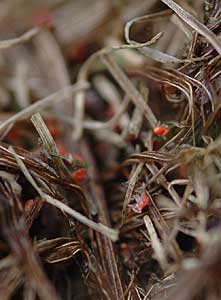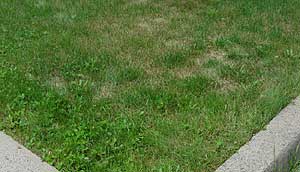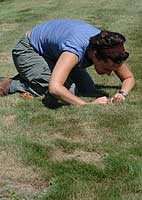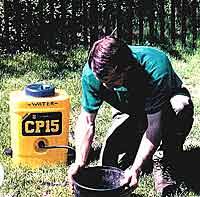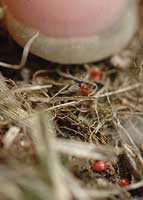VI CONTROL: Overview Acute Cultural Redesign
VII GUIDELINES | VIII PHOTOS | IX REFERENCES
QG CHINCH NOW
| ||||
| A resident or property manager may want to look for chinch bugs in order to anticipate possible damage later in the season, or to confirm that patches of dying grass observed in July and August are due to chinch bug. Monitoring is an essential part of a progam for control of chinch at sites where it has caused damage in previous years. The monitoring process is largely a matter of keeping an eye out for early signs of possible damage by chinch and confirming that chinch bugs are present in large numbers at the margins of the affected area. |
1. When to LookIn HRM, be on the lookout by July 1. Being watchful at least one to two weeks earlier than July 1 may be advisable if spring and early summer are exceptionally warm, or in warmer, inland regions. Development time of chinch bug is temperature dependent. Growing degree-days, which can be calculated from commonly available climatic data, are commonly used as a predictor of development times. Chinch bug/growing degree-day relationships have been reported for Ontario, Quebec and, recently, by Wellwood et al.[C4] for several municipalities in New Brunswick. In the that study, numbers of second and third instar nymphs peaked between mid-July and mid-August. Based on growing degree-days for normal years, they recommended monitoring for chinch bugs from July 1 to mid-August for Rothesay, Bathurst and Moncton, and slightly earlier for Fredericton. Growing degree days for HRM are close to those for Rothesay. The first dates are approximately two weeks before the first pesticide control decisions are advised by Wellwood et al.[C4] under an IPM system. The control times (mid July to mid-August for Rothesay and inferred for HRM) correspond to peak 2nd and 3rd instar populations. Applying control treatments at this stage is considered to be optimal because all eggs have hatched and the early stage nymphs are more susceptible to treatment and less mobile than later stages.[C1] The monitoring and control dates advised by Wellwood et al.[C4] related to use of pesticides under an IPM system*. However, they are also relevant to use of alternative treatments (Section V) under a pesticide-free system as in HRM. The message: start looking by July 1, or earlier if spring and early summer are exceptionally warm, or in warmer, inland regions. IPM refers to 'Integrated Pest Management'. It is often promoted as an alternative to pesticide bans. However, while it is in principle it sought to reduce pesticide use, under IPM practiced by most of the lawncare industry, it is not attempted to eliminate their use and it is acknowledged that in some instances, use might even be increased. This sort of IPM cannot be regarded as a step in a transiton to complete elimination of pesticides, as sometimes seems to be implied. The term 'Biointensive IPM' is used to describe IPM that makes use of only soft pesticides, and emphasizes cultural control of pests first and foremost. (See www.attra.org/attra-pub/ipm.html for more on Biointensive IPM.) 2. Where to LookIn scientific studies, and in some monitoring programs in which counts of chinch are made before there are any visible signs of damage, random sampling may be necessary or advised. (Random sampling means not prejudging where to look). Otherwise, on large properties one should look preferentially or give priority to looking in areas that are prone to drying out (drier, full sun areas, especially on south facing slopes, mounds, edges of turfs and the sides of buildings where heat is radiated)[C1, L3] especially if they had chinch in previous years. (On smaller properties, it's pretty easy to survey the whole lawn.)
3. Exposing ChinchThere are two general approaches: observation of chinch bugs in place, and observation after physical removal of chinch bugs. [C1-C5; C10-15]A. Direct Observation
Chinch bugs can also be detected by sprinkling 1/4 cup of lemon-scented household detergent mixed in two gallons of water over one square yard of turf and counting the insects as they crawl to the surface.Here's another version:[C16] Use 4 to 6 ounces of liquid soap in 5 gallons of water and pour on a 4 square foot area to check for soil insects [such] as mole crickets. Slowly slide your foot through the sod and water; chinch bugs crawl across your shoe if they are present. B. Physical RemovalTwo techniques — flotation and the soap and flannel sheet trap — are commonly cited. Congdon and Buss[C9] suggest use of a vacuum cleaner.
Flotation. Flotation techniques are used in formal, quantitative surveys of chinch populations.[C1] Many documents describe a coffee can procedure for home use. The following version incorporates suggestions and comments from many sources.[C1-C5; C10-15] Cut out both ends of a large can, such as a large coffee can. A variant on this procedure is to take out a sample of turf and submerge it:[C10] ....using a hole cutter, remove a sample of turf and soil, place it into a bucket, and slowly add warm water to the top of the grass blades. Let the soil and turf core soak for several minutes, and then count the number of insects that emerge. Soap and flannel sheet trap A small area of lawn (approx. 50 x 50 cm) is drenched with a soapy solution (30 mL of dishwater soap in 7 liters of water) and covered with a flannel sheet for 15 minutes; chinch crawl onto the sheet, where they can be inspected (and vacuumed or rinsed off). Vacuuming As a less labor-intensive option, Congdon and Buss [C9] suggest the following:Use a Dust Buster or hand-held vacuum cleaner to suck up any chinch bugs near damaged areas. Remove the filter, dump the contents on the sidewalk, and look for nymphs and adults. Repeat in several damaged areas. 4. Close Examination to Confirm Chinch
5. How Many Chinch Bugs Are Too Many?It depends on grass health and broadleaf cover.First it depends on how the chinch bugs are being observed. Flotation techniques are used in scientific studies to determine the total numbers of chinch. However, they are not practical for routine monitoring. Wellwood et al.[C4] calibrated a direct observation technique against numbers determined by flotation.[C4] They observed chinch bugs in quadrats of 0.1 m2 area (slightly more than 30 cm x 30 cm or 1 foot by 1 foot), which took an average of only 3 minutes versus 17 for the flotation technique. The numbers revealed by the flotation technique were approximately 10 fold those revealed by the quadrat technique. Secondly, it depends on the health of the turf and the broadleaf cover. The surveys in New Brunswick[C4] indicated that below a count of 10 chinch bugs per 0.1 m2 in a 60 second search (by experienced observers) no damage was likely. Above 10 chinch bugs per 0.1 m2, damage was possible, but depended on the general health of the turf or on broadleaf cover.
Presence of broadleaf cover is especially significant. Wellwood et al.[C4] noted that "lawns with higher populations of broadleaf plants (weeds) ~10% showed less visible damage from chinch bug feeding than lawns with fewer weeds despite above threshold HCB populations." (HCB refers to hairy chinch bug.) Weeds in their definition would include white clover, which if allowed to proliferate can amount to over 40% of the cover in July.[L25] Wellwood et al.[C4]describe undamaged turf with 10 chinch bugs per 0.1 m2 or more (by direct observation) as 'hotspots' of chinch activity. With experience, they say that it takes less than one minute to determine whether the numbers of chinch in a quadrat are above ten. Because of the importance of turf health and broadleaf cover in determining whether hot spots of activity actually damage the turf, they advise NOT to treat such areas immediately. Instead, they advise re-examining the hotspots at weekly intervals, and treating them only if damage is actually observed. In practice, this procedure is very similar to keeping an eye out for early signs of possible damage by chinch bugs, and confirming (or not) by direct observation that chinch bugs are present in high numbers at the junction of damaged and undamaged areas.
Start looking out for early signs of damage - small patches of dying grass - by early July, paying special attention to areas prone to dying out. This could be done before mowing each week, or by just generally keeping an eye out for damage when using the lawn. Get on your hands and knees and, part the grass in the region of the junction of dying and healthy grass, and look for high concentrations of chinch bugs. In the early stages of damage, these will consist mostly of bright red nymphs; later there will be many winged adults which scatter quickly. Pouring some dilute soap solution over the patch will slow them down. Compare abundance at the junction with numbers in adjacent healthy grass. Examine more patches if chinch bugs aren't found in the first one. If the damage is due to chinch, you will find chinch bugs; if it isn't, you won't find them, or you will find only a few and not more than in healthy grass. Initially, you might take a little extra time to become familiar with chinch bugs, perhaps collecting some by flotation or other techniques, or using a magnifying glass. If you are dealing with an area that had been heavily damaged by chinch in previous years, it could be examined for chinch before there is obvious damage, e.g., to assess whether changes in cultural practices (Section VI) seem to be working. Links
Top of Page I HOME | II BIOLOGY | III MONITORING | IV FACTORS | V PERMITTED MATERIALS VI CONTROL: Overview Acute Cultural Redesign VII GUIDELINES | VIII PHOTOS | IX REFERENCES QG CHINCH NOW Site posted 5 Apr. 2004
This page posted 12 Apr. 2004 Page modified 16 May 2007. |
